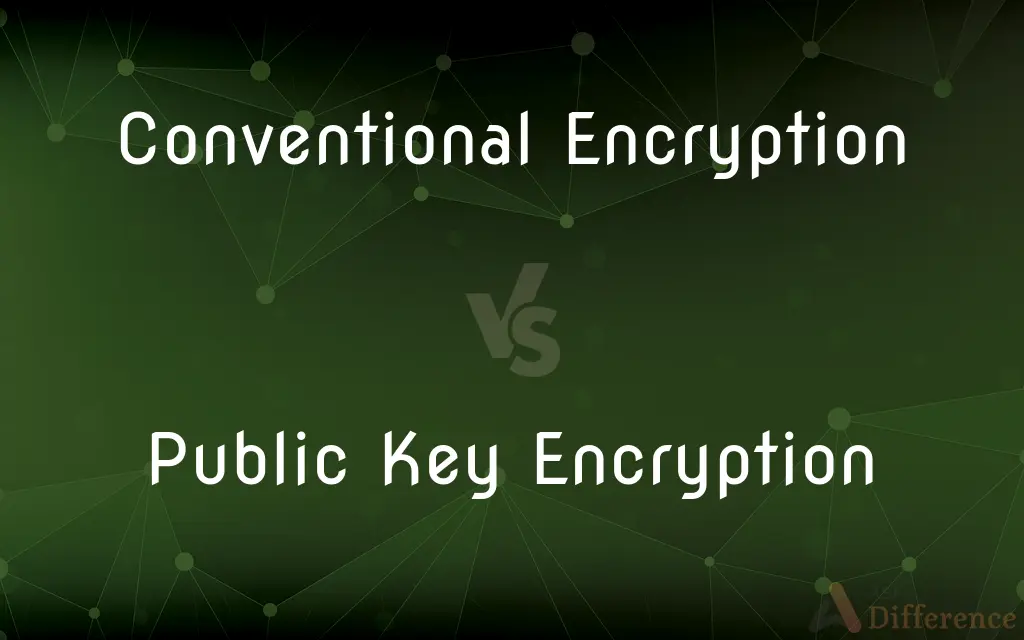Conventional Encryption vs. Public Key Encryption — What's the Difference?
By Tayyaba Rehman — Published on January 19, 2024
Conventional Encryption uses a single key for both encryption and decryption, whereas Public Key Encryption employs two keys: a public key for encryption and a private key for decryption.

Difference Between Conventional Encryption and Public Key Encryption
Table of Contents
ADVERTISEMENT
Key Differences
Conventional Encryption, also known as symmetric encryption, involves a single key that both the sender and the receiver use for encrypting and decrypting messages. Public Key Encryption, or asymmetric encryption, uses a pair of keys: a public key, which anyone can use to encrypt a message, and a private key, which is kept secret by the receiver to decrypt the message.
In Conventional Encryption, the key must be kept secret and shared securely between parties, as anyone with the key can decrypt the information. In contrast, Public Key Encryption allows for more secure key distribution, as the public key can be shared openly without compromising security.
The process of encryption and decryption in Conventional Encryption is generally faster due to the use of simpler algorithms. Public Key Encryption tends to be slower because of the complexity involved in using two keys and more computationally intensive algorithms.
For Conventional Encryption, the main challenge lies in securely exchanging the key. Public Key Encryption, while solving the key exchange problem, faces challenges in ensuring the security of the private key, as its compromise leads to the vulnerability of the encrypted data.
Conventional Encryption is widely used for encrypting data in transit due to its speed and efficiency. Public Key Encryption is often used in digital signatures and establishing secure communications, like in SSL/TLS protocols for secure internet connections.
ADVERTISEMENT
Comparison Chart
Key Type
Single shared key
Two keys (public and private)
Key Distribution
Secure sharing required
Public key openly shared
Speed
Faster due to simpler algorithms
Slower due to computational complexity
Main Challenge
Secure key exchange
Securing the private key
Common Uses
Data in transit encryption
Digital signatures, secure communications
Compare with Definitions
Conventional Encryption
It is efficient for large volumes of data.
For encrypting their database, they chose conventional encryption.
Public Key Encryption
Public Key Encryption is essential for digital signatures.
To verify the document's integrity, they used public key encryption for the digital signature.
Conventional Encryption
Conventional Encryption is also known as symmetric encryption.
Symmetric or conventional encryption was preferred for its speed.
Public Key Encryption
The public key is openly shared, while the private key remains confidential.
Her public key was available on the company directory for secure communication.
Conventional Encryption
Conventional Encryption is widely used for encrypting data in transit.
The company used conventional encryption to secure its internal communications.
Public Key Encryption
Public Key Encryption involves two keys: a public key for encryption and a private key for decryption.
He used the recipient's public key to encrypt the email.
Conventional Encryption
Conventional Encryption uses a single key for both encrypting and decrypting data.
They encrypted the file using conventional encryption before sending it.
Public Key Encryption
Public Key Encryption is used in SSL/TLS protocols for internet security.
SSL certificates rely on public key encryption to secure websites.
Conventional Encryption
It requires secure key exchange between parties.
A secure channel was used to exchange the key for conventional encryption.
Public Key Encryption
It secures sensitive online transactions.
Online banking transactions use public key encryption for enhanced security.
Common Curiosities
Is Conventional Encryption faster than Public Key Encryption?
Yes, it's generally faster due to simpler algorithms.
How are keys distributed in Public Key Encryption?
The public key is shared openly, while the private key is kept confidential.
Is Public Key Encryption suitable for large data volumes?
It's less efficient for large volumes due to its computational complexity.
How is the key managed in Conventional Encryption?
The key must be securely shared and kept secret between parties.
What is the main challenge in Conventional Encryption?
The main challenge is securely exchanging the encryption key.
Can Public Key Encryption be used for digital signatures?
Yes, it's commonly used for creating and verifying digital signatures.
Can Public Key Encryption be combined with Conventional Encryption?
Yes, in many security protocols, they are used together for efficiency and security.
What is Conventional Encryption?
It's encryption using the same key for encryption and decryption.
What is Public Key Encryption?
It uses two keys – a public key for encryption and a private key for decryption.
What happens if the key in Conventional Encryption is compromised?
If compromised, it can lead to unauthorized access to all encrypted data.
Are both types of encryption secure?
Yes, but their security depends on key management and algorithm strength.
What role does Public Key Encryption play in internet security?
It's crucial for SSL/TLS protocols and securing online transactions.
How is the private key in Public Key Encryption protected?
It should be stored securely, often encrypted and accessible only to the owner.
Are there different algorithms for these encryption types?
Yes, each type uses different cryptographic algorithms suited to their key structure.
Can Conventional Encryption be used online?
Yes, it's often used for encrypting data in transit online.
Share Your Discovery

Previous Comparison
PayPal Here vs. iZettle
Next Comparison
Harman Onyx 3 vs. Harman Onyx 4Author Spotlight
Written by
Tayyaba RehmanTayyaba Rehman is a distinguished writer, currently serving as a primary contributor to askdifference.com. As a researcher in semantics and etymology, Tayyaba's passion for the complexity of languages and their distinctions has found a perfect home on the platform. Tayyaba delves into the intricacies of language, distinguishing between commonly confused words and phrases, thereby providing clarity for readers worldwide.














































